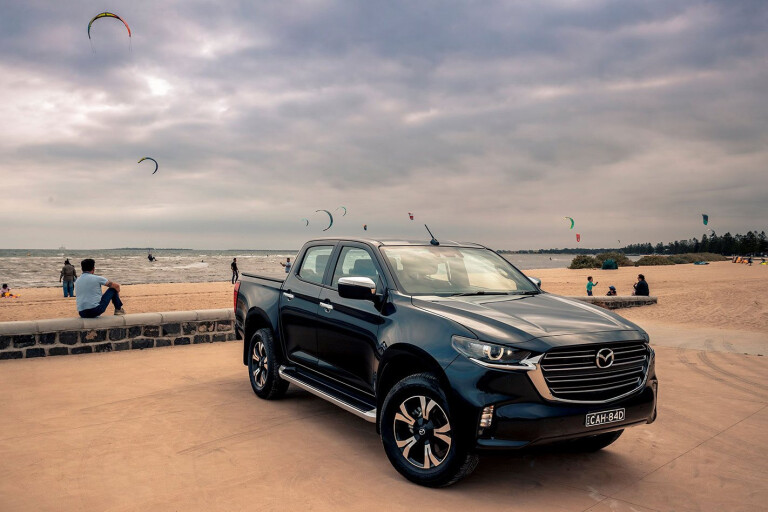
- Jump to Update 2: March 2021
Update 1: February 2021
Living with the Mazda BT-50 GT 4x4
Welcome to the family, big fella
Km travelled: 1100
Fuel economy: 8.2L/100km
Can Mazda’s Zoom Zoom ethos, which imbues everyday cars with driving spirit, do the same for a dual-cab ute? That’s the question at the heart of this long-term test.
There’s no ignoring the popularity of utes in Australia right now. In 2020, two of the three best-selling vehicles were dual-cab 4x4 utes – Ford Ranger and Toyota Hilux. One in five new vehicles bought by Australians in 2020 was a ute. Same for 2019 and 2018 and 2017…
So, if Mazda gets the mix right, the BT-50 could be a big seller for the Japanese brand.
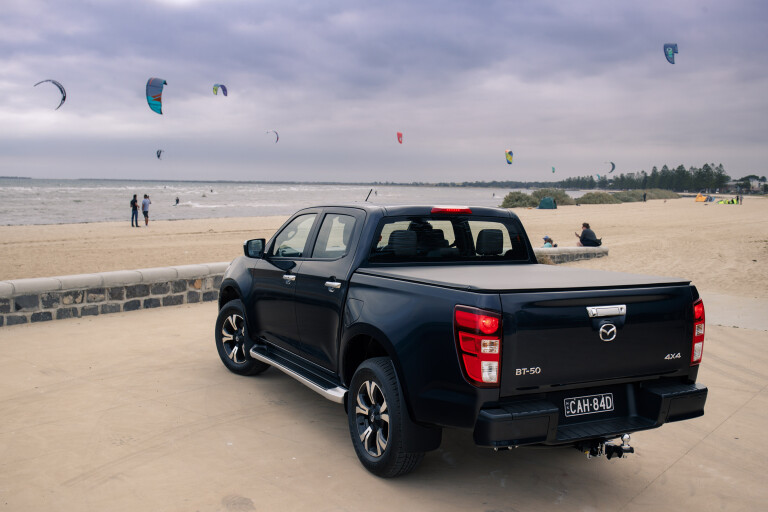
The appeal with utes is not hard to see. They look big and tough and unbreakable, and they are as close as it gets to the automotive Swiss Army knife. Naturally, dual-cab 4x4s appeal to tradies who need the tray for work.
For us non-tradies, they can handle the everyday with ease, go off-road, tow a boat or a caravan or a horse float, and carry plenty of Ikea flatpacks in the tray. What’s not to love? Parking a 5.28m long ute in supermarkets, for starters. But we’ll get to that.
I want to see how the Mazda BT-50 – one of the newest utes on the block as of January 2021 – keeps up with my weekday work commutes and weekend DIY duties. You see, we bought a house during the 2020 Covid pandemic and it needs a lot of work.
There is a second kitchen that needs to become an office/guest room – who needs two kitchens? There are about 40 tonnes of concrete instead of a backyard that’s also destined for the tip, a garage that needs a five-door storage cupboard built into it, and copious painting inside and landscaping outside. Seriously, Bunnings is going to love me.
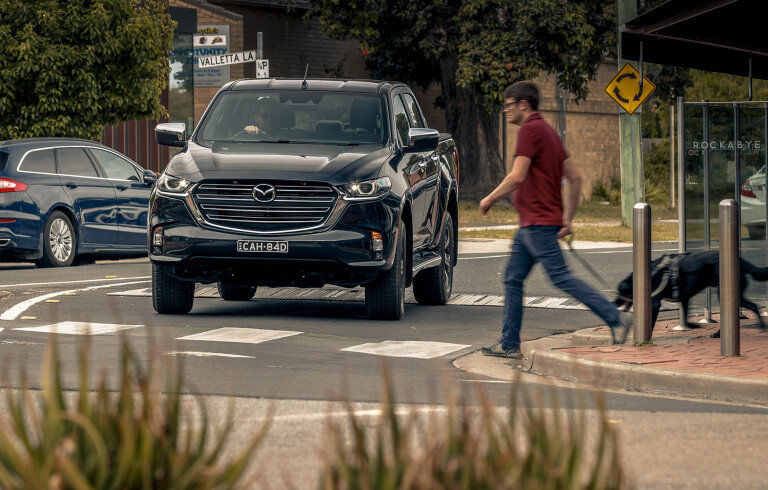
The BT-50 GT will have to keep up with all of that – except lugging 40 tonnes of concrete to the tip. I’ll get a skip or two for that. Plus, it needs to cart me, the wife and our Covid baby around as we live our lives. That part, in particular, will test the BT-50’s newfound interior class.
This Mazda BT-50 launched in Australia in October 2020, replacing the previous generation which had been around since 2010. There was a mid-life facelift in 2015 which introduced Apple Carplay and Android Auto and a few styling tweaks, but nothing mechanical or substantial.
This third-generation Mazda BT-50 is all-new. Now, when car companies throw around the term “all-new” it is often nothing more than a firewalker’s affirmation – “My feet are not burning, the coals are not hot” – all the way to the emergency ward.

With this third-generation Mazda BT-50 the “all-new” is all-true. Where the last BT-50 was co-developed with Ford on the Ford Ranger chassis, this one is the result of a partnership with Isuzu.
So, everything short of the Mazda badge on its nose is new. That’s a good thing because, even though the last BT-50 wasn’t bad, the Isuzu D-Max’s reputation for bulletproof reliability and trust is second to none with owners.
Styling-wise, the new BT-50 is a more handsome machine than its somewhat cartoonish predecessor, with lines similar to Mazda’s popular passenger car and SUV range. I like it, but I’m tipping that some tradies and weekend warriors who like their utes to look tougher than the Terminator may think the BT-50 a bit soft.
All Mazda BT-50 models come with alloy wheels and LED headlamps on the outside, remote central locking, cruise control, air-conditioning, and electric power windows and mirrors on the inside.
Bluetooth, Apple Carplay (and Android Auto), and digital radio are also standard, coupled with a seven-inch touchscreen. The second row of seats gets air vents and a second USB charging point, and is spacious enough for adults, although the high floor means adult legs won’t have decent under-thigh support on longer journeys.

The GT model I’ve got has a full leather interior (brown), electrically adjustable and heated seats, a fold-down armrest in the rear, electrically folding heated mirrors (chrome wrapped), and front parking sensors.
Inside, it gets dual-zone climate control which works well on hot days, a nine-inch touchscreen which now includes satellite navigation but has volume buttons instead of an easy volume knob and a USB point that is capable of charging my Samsung Galaxy Note 20 Ultra. That last point is a talent not all car USB points can claim.
The entertainment system shares nothing with any other Mazda I’ve driven, though it is pretty much identical to the one in the Isuzu D-Max. Many of the system’s settings are ‘locked out’ while on the move, presumably for safety reasons.
For example, the passenger cannot enter an address into the satnav unless the car is stopped. And messing with the satnav settings is also off the menu while moving, which means you need to mentally store up any adjustments until you arrive at your destination. At which point, if you’re like me, your mind is on what you need to do at said destination, not fine-tuning the satnav settings for next time.

The BT-50’s driving position is very good and remains comfortable on extended drives. (I’m talking two hours, not 10. Haven’t done that yet.) The seat has plenty of electrical adjustment and the steering wheel tilts and telescopes.
Visibility is also good, although there’s no getting around the fact that this is one long and large vehicle. Still, big mirrors, parking sensors and a reversing camera help take some of the pain out of manoeuvring.
The door pockets hold big water bottles, there is a storage bin under the front armrest and two gloveboxes in front of the passenger – although the very big car manual takes up most of one.
The BT-50 does not have a mobile phone charging mat, which many passenger cars do, but I’m struggling to think of a single dual-cab that does… yet.
.jpg )
Putting our baby seat into the back seat is a relatively easy process, firstly because the door opens nice and wide. The tether strap which usually attaches to the seatback – can’t do that in a ute! – threads through a sturdy cloth eyelet under the outboard headrest and onto a steel tether point behind the centre headrest. There’s room enough in the back for the baby seat without forcing the front seat passenger to slide their seat far forward.
While we’re on the subject of keeping the family safe, the BT-50 has an impressive arsenal of features to help you do exactly that. Standard safety kit on all BT-50 models includes the usual array of airbags, a reversing camera, autonomous emergency braking (AEB), electronic stability control, blind-spot monitoring, emergency lane keeping and lane departure warning, rear cross-traffic alert and a speed assist system.
It’s a safety suite that, along with its occupant protection capabilities in a crash, is enough to score the BT-50 the full five-star ANCAP rating. It is also kit that few utes would have boasted just five years ago, including the previous generation BT-50. These days, however, many of BT-50’s rivals have comparable safety credentials, but none beat the Mazda.
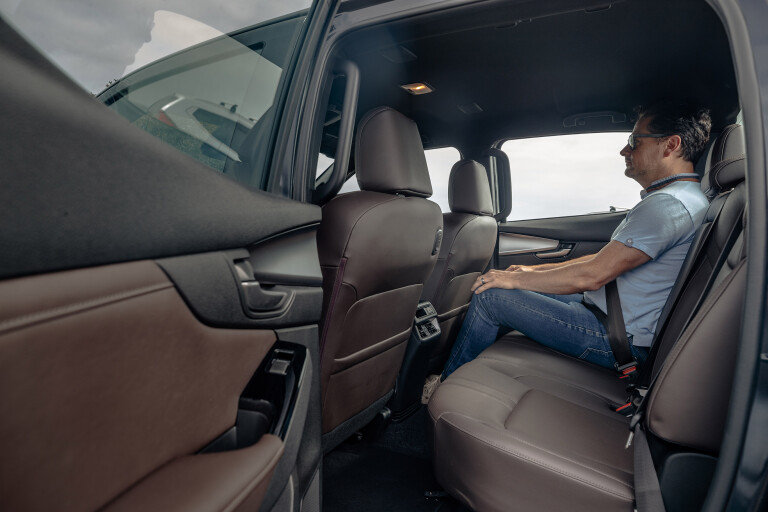
Having a long list of active and passive safety features is attractive on the showroom floor, but ultimately it comes down to how they work in the real world. So far, my experience has been a mixed bag, primarily because some of the systems are too conservative.
The autonomous emergency braking sometimes triggers when a car in front is turning left, which not only scares me but also the hard-braking car behind me. The blind-spot assist is overzealous with warnings of cars in the next lane when I indicate to change, and the lane departure prevention sometimes tries to overrule my attempts to change lanes even though the gap is there.
I’m not game to try the BT-50’s intelligent speed limiter which is said to keep the car’s speed below the speed limit shown on traffic signs, because I’ve caught it misreading digital signs a couple of times – one of which was on the Monash Freeway when it thought 80km/h was 40km/h. Imagine the speeding fine I’d cop if it read it the other way.
All these ‘safety’ systems should assist the driver’s awareness, not detract from it. I’ve got a meeting with Mazda shortly to help me understand the different systems better and to attend to a couple of minor niggles elsewhere.
Niggles like the GT’s propensity to relock itself after I put something in the passenger side and walk around to the driver’s side (possibly something to do with the GT’s advanced keyless entry system which, thankfully, includes a touchpad on the driver’s door).
And how to set the clock in the instrument binnacle which shows a completely different time to the one on the entertainment system. Little niggles, but the kind an owner would want to be addressed.
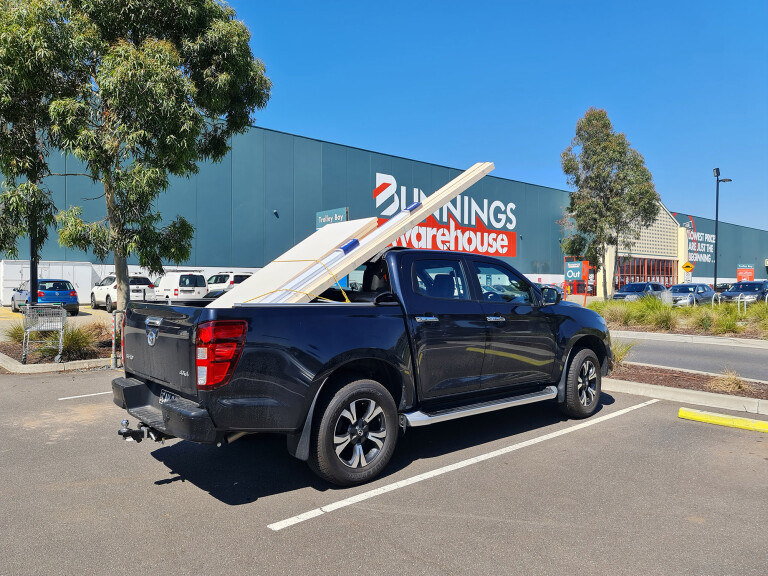
Now, let’s get to the elephant in the boot. The biggest drawcard with utes is the ute bit, right? And so far this tray – 1530mm wide by 1571mm long before the durable plastic liner standard on the GT and the wheelarches are taken into account – has carried five 2m doors and enough wood to build my big garage cupboard. The cupboard, by the way, has been dubbed the Black Hole because it’s where our possessions will go and never be seen again.
The wheelarches do eat into the width, reducing that measurement to 1110mm at its narrowest, but that was still wide enough for my doors. I did have to lean most of the lumber against the roof – which I protected with a $9 carpet square from Bunnings – and then used the tie-down points in the tray to keep it all safe. It took some effort to get the goods up onto the tray as it’s 828mm off the ground, but that’s on par with its rivals.
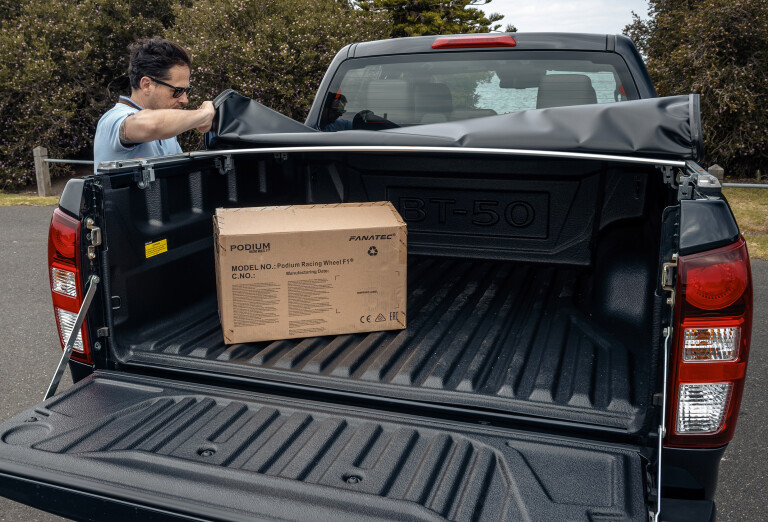
Mazda’s soft tonneau solution ($850) is easy to remove and replace when needed, and there is a good selection of tie-down points in the tray. Some other ute tray-liners I’ve seen have slots to slide a plank into, partitioning the tray to stop smaller loads sliding around. The one fitted to our test car doesn’t.
The Mazda BT-50 dual-cab range has a maximum payload of between 1050kg and 1106kg, although this measurement is meant to include occupants so don’t expect to move a tonne of soil and four people.
With 150kg of Bunnings loot onboard (I had a couple of bags of cement to refurbish the fireplace floor and some potting mix) the BT-50’s Isuzu-sourced 3.0-litre, four-cylinder turbodiesel engine didn’t struggle. In fact, it was hard to tell if the engine and six-speed automatic transmission even knew the load was there. Performance felt just as strong as it did on the drive to Bunnings.
This engine is actually smaller than the 3.2-litre five-cylinder it replaces and has less power and torque, but the BT-50’s 2035kg kerb weight is less than before so Mazda claims performance and fuel economy are improved.
So far, I’ve no complaints with the engine’s pulling power, or the trip computer’s claimed 8.6L/100km around town and 7.6L/100km on a freeway trip to the in-laws in Geelong. The transmission is generally invisible, which is good, although it does hold onto second gear longer than necessary in initial driving – perhaps something to do with the warm-up process?
Now, remember I said earlier that parking in supermarkets is a challenge? That's to be expected with all utes this size. The BT-50's 5.3m length and 3.175m wheelbase means there needs to be a good thoroughfare width between the rows of cars so you can swing the big fella in. Otherwise, you end up shunting back and forth between the rows, a job made as easy as it can be by the GT's reversing camera and parking sensors. Steering at low speeds is relatively light, too, which is good because you will be turning the wheel a lot to get into the parking spot.
Mazda has fitted a tow bar ($855 plus labour) to this car, but I’m yet to put its 3500kg rating to the test. Don’t worry, there are plenty more Bunnings trips planned before the BT-50 goes back to Mazda.
Update 2

Living with the Mazda BT-50 GT 4x4
Month 2 of 4: Where we pretend to be a band of gypsies
Km travelled: 1450
Fuel economy: 7.6L/100km
We had to move out of home last month while the bathroom is being renovated because sledgehammers and sleeping infants don't mix.
Unfortunately, I had to move the family out without the BT-50's help because I promised a colleague a test drive. Instead, I had to cram all our luggage into the car I actually own - a 2011 BMW X5 30d - which joined the family shortly after little Arlo did.
I probably didn't need to buy a car, because the flow of test cars through our office is endless. But buying the X5 was preferable to cramming his baby seat into the back of a different car every week, some of which do not have back doors.
Anyway, back to the temporary relocation. I remember going away with my wife before we had kids. It was a two-bag affair. Not any more.
I had to pack a pram, travel cot, travel change table, travel high-chair, box of toys and baby books, two boxes of food plus an esky, luggage for the three of us, two boxes of nappies, one bag of bedlinen, a few pillows, and another bag with our tech - laptops, tablets, baby monitor, baby light and an endless assortment of chargers.
Fitting it all into the BMW X5 was a Tetris challenge of the highest level, but I love a challenge. It took three starts to get it right, but I got it all into the boot and the back seat, which also had Arlo's backwards-facing car seat. After that, I had no vision through the rear window, and would have struggled to sneak a copy of Wheels magazine in, but hey we were packed and ready.
So, imagine my disappointment a week later when we prepared to depart our temporary accommodation and return home. By then, the BT-50 was back in my care, and its tray devoured everything with ease. In fact, it was so easy that I didn't even need a packing sequence. And I could drive with perfect rearward vision. The BT-50's tray may be no bigger than its main rivals, but there's no denying utes make carrying loads of luggage easier.
One thing I discovered is that the tailgate is not synced to the central locking, so don't leave anything valuable in the tray. Instead, you need to slide the actual metal key out of the keyfob and lock it separately.
.jpg )
This month, I also got to the bottom of all those 'inconveniences' I listed in the first month's update above. In turns out the Mazda BT-50 (and its Isuzu D-Max development sibling) have safety top, middle and bottom of mind at all times. This means you cannot interact with the instrument binnacle settings while the transmission is in Drive, and the passenger cannot enter an address into the satnav or scroll radio presets when the car is moving. It also means the safety warning comes up on the screen every single time you start the car and must be acknowledged every single time too.
Also, Digital Radio cannot be accessed while Android Auto is in use. Weird, that.
I did manage to find settings to adjust the sensitivity of Emergency Brake Assist and Lane Change Warning, although the latter's least sensitive setting is still too hyper for Australian conditions. I also found the clock adjustment and the setting to stop the BT-50 locking itself when the key strays more than three metres from the driver's door.
So, life is much, much better now that the BT-50 and I are more in sync.
Once we got home to our newly renovated bathroom and I had emptied the luggage from the tray, I set off for a nursery in Geelong because Mrs B had ordered nine verbernums and four ornamental pears for the front yard. Verbernum is also known as a quick hedge, which is what we need after bulldozing the palm tree slash yucca disaster that was our front yard.
.jpg ) Driving the Geelong freeway with a tray full of semi-mature trees at under 80km/h to reduce wind-burn on the leaves was no fun for me, but it did allow the big, boxy BT-50 to record an insane 6.9L/100km fuel economy. I also discovered the handy velcro straps that secure the soft tonneau when it's rolled up behind the cabin.
Driving the Geelong freeway with a tray full of semi-mature trees at under 80km/h to reduce wind-burn on the leaves was no fun for me, but it did allow the big, boxy BT-50 to record an insane 6.9L/100km fuel economy. I also discovered the handy velcro straps that secure the soft tonneau when it's rolled up behind the cabin.
Next month, we're bringing in 12 cubic metres of soil and enough turf to cover the MCG. Oh, I'm also painting the entire house, roof and all, and building an L-shapred brick retaining wall around the new turf that will double as a planter box on top. As much as I love driving the Mazda BT-50, and I do, a part of me is tired of Mrs B using it as an excuse to fill my weekends with DIY jobs.
COMMENTS